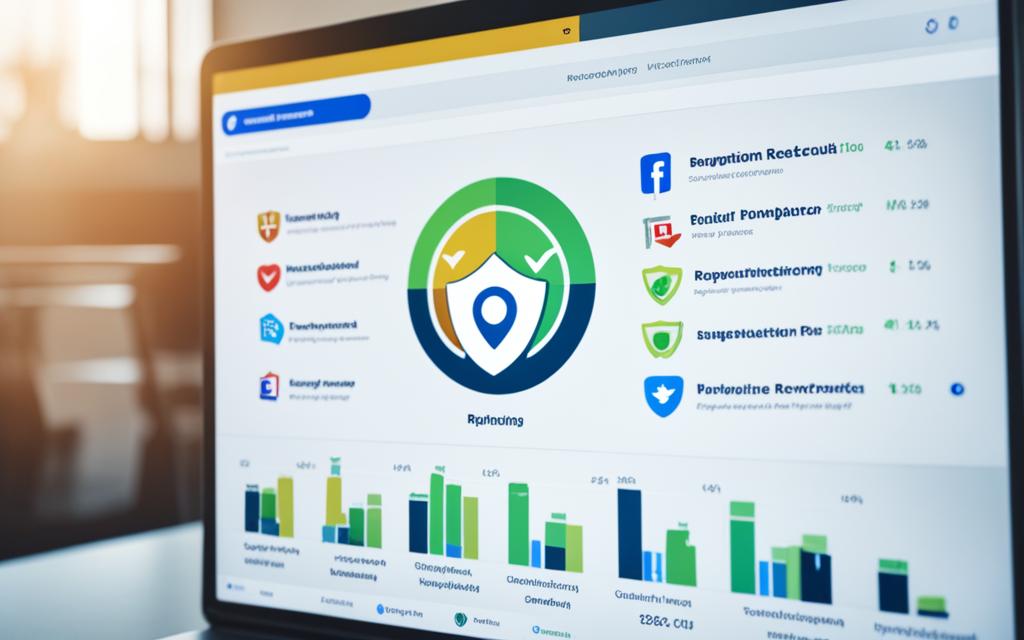Your reputation is more than just an online image—it’s an important asset that can significantly impact your success. This guide is your playbook for navigating the intricacies of developing a strong reputation management strategy, ensuring that your business not only survives, but thrives. Getting proactive, strategic planning, and utilizing the right tools are key to building a robust reputation management strategy that protects your brand and drives long-term success.
Key Takeaways
- Reputation management is crucial for building trust, influencing purchasing decisions, and mitigating potential damage from negative publicity.
- Defining your brand’s core values, identifying target audiences, and setting specific goals are essential steps in developing a strong reputation management strategy.
- Monitoring online conversations, handling negative reviews effectively, and measuring the impact of your efforts are crucial for maintaining a positive brand reputation.
- Adopting best practices like brand safety, proactive communication, and continuous improvement can help you navigate the dynamic landscape of reputation management.
- Leveraging data-driven insights and adjusting your strategy based on results can lead to long-term business success.
What Is a Reputation Management Strategy?
A reputation management strategy is a proactive approach to monitoring, maintaining, and enhancing your brand’s online presence and public perception. It’s crucial for businesses of all sizes, as it can enhance brand trust and credibility, influence customer purchasing decisions, mitigate potential damage from negative publicity, support long-term business success, and affect online visibility and search engine.
Importance of Reputation Management
In today’s digital landscape, a company’s reputation can make or break its success. With 76% of consumers regularly reading online reviews when browsing for local businesses, and 46% believing these reviews are as trustworthy as personal recommendations, the impact of reputation is undeniable.
Enhances Brand Trust and Credibility
Positive reviews and a strong online presence can significantly boost consumer trust in your brand. Products with three- or four-star ratings generate three times more sales than those with one-star ratings, highlighting the importance of managing your reputation.
Influences Customer Purchasing Decisions
According to Glassdoor, 50% of job candidates say they wouldn’t work at a company with a bad reputation even if they received a pay raise. This underscores how reputation can directly impact customer purchasing decisions and long-term business success.
Mitigates Potential Damage from Negative Publicity
Effective reputation management helps businesses respond quickly and effectively to negative comments or reviews, mitigating the potential damage they can cause. When companies take too long to respond to customer issues, 36% of consumers say they’ll share the negative experience with friends and family, 31% won’t complete their purchase, and 30% will buy from a competitor.
Supports Long-Term Business Success
A strong reputation management strategy can help businesses weather challenging times and maintain a positive public perception, ultimately contributing to long-term success and growth.
Affects Online Visibility and Search Engine Rankings
Online reputation management also plays a crucial role in improving a business’s visibility and search engine rankings. Positive reviews, high-quality content, and a well-maintained online presence can significantly boost a company’s online discoverability and authority.
Monitoring Online Reputation
Maintaining a strong online reputation is paramount in today’s digital landscape. Regularly monitoring your online reputation is a necessity to stay on top of the vast expanse of the internet. This includes diligently searching for mentions across various platforms, leveraging social media listening tools and Google Alerts, closely tracking reviews on sites like Yelp and Google, and staying updated on industry trends and discussions.
Responding promptly to emerging issues is crucial for effective damage control and showcasing your commitment to customer care. By proactively monitoring your online presence, you can address any potential problems before they escalate, preserving your brand’s credibility and trust with your audience.
- Utilize social media listening tools to track brand mentions, conversations, and industry trends in real-time.
- Set up Google Alerts to receive notifications whenever your brand, products, or key industry keywords are mentioned online.
- Regularly review online reviews on platforms like Yelp, Google, and industry-specific sites to address customer feedback promptly.
Effective online reputation monitoring empowers you to stay ahead of the curve, identify potential issues, and proactively maintain a positive online presence. By investing in comprehensive reputation management strategies, you can safeguard your brand’s reputation and foster lasting relationships with your customers.

5 Steps to Building a Strong reputation management strategy
Crafting a robust reputation management plan is crucial in the digital age. By following these five essential steps, you can establish a solid foundation for managing your brand’s reputation and safeguarding your online presence.
Step 1: Define Your Brand’s Core Values and Messaging
Start by clearly defining your brand’s core values and developing a consistent messaging strategy. This will help you communicate your brand’s identity and principles to your target audience, ensuring a cohesive and authentic online presence.
Step 2: Identify Target Audiences and Key Stakeholders
Understand who your key stakeholders are, including customers, employees, industry influencers, and the broader community. Tailor your brand management approach to address the unique needs and expectations of each group.
Step 3: Set Specific Reputation Management Goals and Objectives
Establish clear, measurable goals for your reputation management strategy. This could include improving online ratings and reviews, increasing brand visibility, or mitigating the impact of any potential crisis management situations.
Step 4: Develop a Crisis Management Plan
Anticipate potential crises and have a well-defined plan in place to respond effectively. This may involve monitoring online conversations, crafting pre-approved messaging, and establishing communication protocols to address negative situations quickly and appropriately.
Step 5: Establish Guidelines for Online Engagement and Responses
Implement clear guidelines for how your brand will engage with customers and stakeholders online. This includes determining the appropriate tone, response times, and escalation procedures for handling both positive and negative feedback.
By following these five steps, you can build a comprehensive reputation management strategy that protects your brand’s image, fosters trust with your audience, and supports long-term business success.
Handling Negative Comments or Reviews
In the digital age, online reputation repair has become essential for businesses and individuals alike. Negative comments or reviews can quickly spread and significantly impact brand trust and credibility, influencing customer purchasing decisions. Responding to these challenges requires a professional and empathetic approach.
The recommended response time for addressing negative reviews is within 24-48 hours. Different online review platforms have varying rules and regulations, so it’s essential to familiarize yourself with the guidelines of each platform. Remember, 100% of businesses cannot expect only positive reviews, as negative feedback is a natural part of doing business.
- Address the reviewer by name and personalize your response to show you’ve listened to their concerns.
- Avoid engaging in public arguments or defensive responses, as this can further damage your reputation.
- Offer a solution or remedy to the issue, demonstrating your commitment to customer satisfaction.
- Encourage satisfied customers to share positive reviews to counteract the negative feedback and maintain a balanced online presence.
Negative reviews can significantly impact your business’s search engine rankings, potentially lowering your visibility and hindering online discovery. Reputation management services like Beyond Fifteen can help you navigate this challenge, offering expertise in monitoring your online presence, addressing negative feedback, and developing proactive strategies to maintain a positive brand image.
| Negative Review Handling Best Practices | Considerations |
|---|---|
| Respond promptly and professionally | Leaving negative reviews unanswered can give the impression of indifference |
| Offer a solution or remedy | Turning a negative experience into a positive one can help rebuild trust |
| Encourage genuine positive reviews | Positive reviews can outweigh the impact of negative feedback |
| Seek professional help for removal | Certain negative reviews may be eligible for removal, but the process can be challenging |
By adopting a strategic customer experience management approach and leveraging the expertise of reputation management professionals, businesses and individuals can effectively navigate the challenges of negative comments or reviews, safeguarding their online reputation and maintaining a positive brand image.

Measuring and Evaluating Results
Effective reputation management is a continuous process that requires diligent tracking and analysis to drive ongoing improvements. To measure the success of your reputation management strategy, it’s crucial to monitor key performance indicators (KPIs) that provide insights into your brand’s online presence, customer sentiment, and overall performance.
Track Key Performance Indicators (KPIs)
Start by identifying the most relevant KPIs for your business, such as brand sentiment, online engagement rates, search engine rankings, and customer reviews. Regularly collect and analyze this data to gain a comprehensive understanding of your reputation’s health and identify areas for improvement.
Use Online Reputation Management Tools for Analytics
Leverage specialized reputation management software and reputation management analytics tools to automate the process of monitoring your online presence and reputation. These powerful platforms can help you track mentions, analyze sentiment, and generate detailed reports to guide your decision-making.
Compare Current Data to Benchmarks and Past Performance
To measure the effectiveness of your reputation management efforts, compare your current data to industry benchmarks and your own historical performance. This will help you identify trends, gauge the impact of your strategies, and make informed decisions about future adjustments.
Adjust Your Strategy Based on Results and Feedback
Continuously monitor your reputation management KPIs and be prepared to adjust your strategy based on the results and feedback from your target audiences. By staying agile and responsive, you can refine your approach to optimize your reputation performance tracking and deliver the best possible outcomes for your brand.
Must-Know Reputation Management Best Practices
Maintaining a positive online reputation is crucial for the success of any business. To achieve this, it’s essential to adopt a proactive approach to reputation management. One of the key best practices is being proactive with media relations. This involves actively engaging with journalists and media outlets to share positive stories about your brand and control the narrative during times of crisis.
Leveraging tools like Agility PR’s media contact database can be a game-changer in this regard, allowing you to connect with the right influencers and secure valuable media coverage. Additionally, responding promptly to emerging issues and addressing them before they escalate is crucial for mitigating potential damage to your reputation.
Consistency and a strategic, data-driven approach are also essential for long-term reputation management success. By regularly monitoring your online presence, tracking key performance indicators (KPIs), and making data-informed adjustments to your strategy, you can ensure that your reputation remains strong and resilient.
Remember, proactive reputation management, effective media relations, and a robust crisis communication plan are the cornerstones of a successful online reputation management strategy. By embracing these best practices, you can position your brand for long-term success and build a strong, trusted relationship with your audience.
In today’s digital landscape, where information moves at lightning speed, a proactive approach to reputation management is no longer an option – it’s a necessity. By staying ahead of the curve and implementing these best practices, you can ensure that your brand’s reputation remains strong and resilient, even in the face of unexpected challenges.
Conclusion
Cultivating a strong, positive reputation management strategy is a long-term endeavor that requires a well-crafted approach and consistent effort. By implementing proactive monitoring, strategic planning, and data-driven optimization, you can protect your brand’s image, enhance customer trust, and drive long-term business success in the digital age.
Remember, your brand reputation is one of your most valuable assets – invest in it wisely. Leverage the power of online reputation management to build trust, boost visibility, and position your business for lasting success in the ever-evolving digital landscape.
By staying proactive, responsive, and adaptable, you can navigate the nuances of managing your online presence and maintain a strong, positive reputation that resonates with your target audience. Embrace the opportunity to showcase your brand’s unique strengths and values, and let your reputation be a testament to your unwavering commitment to excellence.

